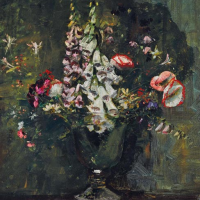45. ARTHUR STREETON

I dont go into Melbourne more than I can help. I spend my days working in the garden.1
Arthur Streetons 1936 letter to Lionel Lindsay conveys a notion of a man at the end of his career, in retirement. In 1921 Streeton had bought five acres at Olinda in the Dandenongs, built a house there, and in the following years began to spend more time there. He devoted himself to enjoying his garden and the surrounding forest, while continuing to paint and exhibit his work.
The paintings produced in these later years were, therefore, created against a backdrop of nature and domesticity, although Streeton showed no signs of reducing his output. Typically, he could produce enough work to have an annual exhibition, and participate in numerous group exhibitions.
The aesthetic concept which he personified in the years leading up to the First World War, champion of the Australian idyll at the fringes of Empire, the concept which had animated the expat Streeton in London for the years of his professional peak, now subsided as he returned to Australia and assumed the life of an artistic minence. Like many who returned from the First World War, home life may have taken some getting used to.
The character of Streetons work underwent a subtle change. On the surface we see the same technical virtuosity, as great a source of wonder to his contemporaries as it is today. To it he added a certain polished quality, the product of his lifes experience, giving his work in this period a timeless grandeur that was not present in his earlier work.
Streetons growing interest in the forest and landscape around Olinda also provide the artist with a ready subject which could appropriately engage his sense of morality. The fringes of growing Melbourne now also take on a discretely melancholic air as he comes to the realisation that the landscape that he loves is now being destroyed by progress.
The flower subjects that had intermittently interested and engaged Streeton earlier in his career were, like the forest, a subject that was both convenient and close to hand, while also offering the older Streeton a gentler and more contemplative challenge. From around 1920, it is estimated that Streeton produced around one hundred and fifty paintings of flowers.2
It seems clear that Streeton enjoyed painting flowers and the subject was also highly rated by critics and collectors. A report in the Sydney Morning Herald of 1931 records how a bunch of crimson roses on the wall, so real, so perfect that one of the roses looked as if it was about to wilt. Only a master hand had been at work on that canvas.3 The subject demanded and inspired technical ability, with the freshness of the blooms, and reflections and shine of the vases against a sketched interior as backdrop, offering the artist great scope for a display of painting pyrotechnics.
In recent years a number of auction sales of Streeton flower paintings indicate an increasing interest amongst collectors for the subject, with high prices and active competition amongst bidders. Arthur Streetons timeless work continues to defy fashion and trends, and with his work constantly in demand and, incidentally, currently on display in Londons National Gallery, his position as the most prominent Australian artist of his generation is confirmed.
Footnotes
1. Arthur Streeton, letter to Lionel Lindsay 6 June 1936, quoted from Eagle, M., The Oil Paintings of Arthur Streeton in the National Gallery of Australia, National Gallery of Australia, Canberra, 1994, p.207
2. Ibid, p.170
3. Sydney Morning Herald, 10 December 1931, p.4
Timothy Abdallah